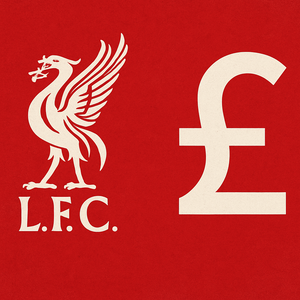For years, Liverpool have operated with precision in the transfer market — balancing smart signings with fiscal responsibility and always toeing the line between ambition and sustainability. But this summer, something has shifted.
With headline signings like Florian Wirtz, Jeremie Frimpong, Milos Kerkez, Hugo Ekitike, and now potentially Alexander Isak — the Reds already have unleashed an unprecedented spending spree nearing £300 million. Fans and rivals alike are asking the same question: how can Liverpool afford all this?
The answer lies in what they didn’t do — and in what they’ve been quietly building behind the scenes for the last two seasons.
2024: A Window of Restraint
In the summer of 2023, Liverpool fans were primed for a midfield overhaul. Jordan Henderson and Fabinho had left for Saudi Arabia, while James Milner, Naby Keïta, and Alex Oxlade-Chamberlain also moved on. The club responded with smart, but not extravagant, business: Alexis Mac Allister (£35m), Dominik Szoboszlai (£60m), Wataru Endō (£16.2m), and Ryan Gravenberch (£34m) were brought in — totaling around £145 million.
But that was the peak of their aggression.
In the January 2024 window, Liverpool made no significant additions. And come summer 2024 — despite finishing the season in a respectable position and qualifying for the Champions League — they barely dipped into the market. Only Federico Chiesa arrived in a modest move, with Giorgi Mamardashvili's transfer delayed and finalized later.
The result? Liverpool spent less than £15 million in the entire 2024 calendar year on transfers.
It was, as critics noted at the time, a strangely passive approach for a club in transition. But behind the scenes, it was part of a bigger plan.
- 0 new signings
— Braden (Fan) 🐦🔥 (@Braden_LFC) August 19, 2024
- 0 new contracts for Trent, VVD, Salah
- Can’t sell players like Phillips and Sepp
- Has no backup plans for a number 6
Richard Hughes… pic.twitter.com/wD1B2EEDPW
A Financial Platform for Explosive Growth
While Liverpool sat quiet in the market, the club’s financial engine roared louder than ever.
Between the 2022–23 and 2023–24 seasons, Liverpool’s revenue ballooned past the £600 million mark for the first time in club history. What makes that figure remarkable isn’t just the number — it’s the transformation behind it. Liverpool’s growth hasn’t relied solely on footballing success. It’s been structural, strategic, and sustainable.
Here’s how they did it:
Commercial Revenue Hits Historic Highs
Liverpool are no longer just a football club — they are a global brand. In 2022–23, commercial income surpassed all other revenue streams for the first time, reaching £272 million. That jumped again to £308 million in 2023–24, setting a new club record.
This growth has been fueled by:
- Strategic partnerships with major global brands like Google Pixel, Peloton, Standard Chartered, and AXA.
- Expansion into new markets across Asia and North America, where Liverpool have capitalized on their massive fanbase with regional deals and content platforms.
Bro Liverpool have unreal motion in Asia, how is the stadium this full for a live training session 😂?
— Adika (@Adikastakes) July 24, 2025
- Investment in club-owned media and content, including LFC TV, YouTube, and global fan engagement apps — all of which generate direct revenue streams.
- A revamped retail and e-commerce division, with increased control over merchandising and international distribution.
In short: Liverpool have industrialized their global appeal. They’re not just cashing in on trophies — they’re monetizing attention.
Matchday Revenue Supercharged by Anfield Expansion
The completion of the Anfield Road Stand in 2023 added approximately 7,000 new seats — pushing total capacity to over 61,000. This wasn’t just about optics. It added an estimated £20–25 million annually in matchday income.
Anfield Road redevelopment is expected to be completed for the start of the 2022/23 season.
— TheKop.com (@TheKop_com) February 12, 2020
This will see 7,000 more seats added to our capacity. #LFC pic.twitter.com/IYzcx4o3kI
Matchday revenue rose to £102 million in 2023–24 — up from around £80 million the previous year — putting Liverpool among the elite European clubs in stadium earnings.
And crucially, most of the Anfield expansion was financed through long-term, low-interest loans, structured carefully so as not to impact PSR calculations.
This growth is recurring — Liverpool will earn more from every home match for years to come, without needing to qualify for European finals or sell players to keep the lights on.
Media Revenue Optimization
While Liverpool’s media revenue dipped slightly in 2023–24 due to their participation in the Europa League rather than the Champions League (dropping to £204 million from ~£242 million), this rebounded in 2024–25 with their return to the top European competition.
But even in a “down” year, the club’s media strategy was future-proof:
- They capitalized on broadcast rights stability in the Premier League.
- Expanded content ownership through documentaries, behind-the-scenes media, and streaming content available on LFC platforms.
- Laid the groundwork for direct-to-consumer digital monetization, a growing trend among elite clubs.
With Champions League money recurring, media revenue is expected to exceed £250 million in the upcoming season — pushing overall revenue toward the £650–700 million range.
[🟢] NEW: The Liverpool documentary is set to air in August 2024 to coincide with the start of the Premier League.
— Anfield Sector (@AnfieldSector) April 29, 2024
[@TheAthleticFC] pic.twitter.com/hekPx4Jhgc
A Resilient, Scalable Business Model
The most underrated element of Liverpool’s financial explosion is how balanced and scalable it is.
Unlike clubs overly dependent on owner subsidies or unpredictable European prize money, Liverpool’s income structure is:
- Diverse – spread across three major pillars: commercial, matchday, and media.
- Recurring – built on long-term sponsorships, merchandising, and digital infrastructure.
- Global – no longer reliant on UK-based spending or gate receipts.
Their net debt is manageable (~£314 million total, including stadium-related loans), and their net transfer liabilities are relatively low — meaning they’re not paying off old signings while trying to fund new ones.
In essence, they’ve built a business where each season gets more profitable, not more precarious.
Amortisation: The Silent Engine of Spending Power
One of the most misunderstood concepts in modern football finance is amortisation — the accounting method by which a player's transfer fee is spread evenly over the length of their contract.
Take Florian Wirtz, for example. His £116.5 million fee is the biggest in Liverpool's history, but it won’t hit the books all at once. With Wirtz signing a five-year deal, Liverpool will only “book” about £23 million per year in amortisation costs under PSR calculations — regardless of whether the full fee was paid up front.
This is how Liverpool can spend aggressively without appearing reckless in financial statements. Thanks to their minimal transfer activity in 2024, the club entered 2025 with low amortisation burdens and ample headroom under the Premier League’s Profit and Sustainability Rules.
So, while the actual outlay may total nearly £300 million this summer, the annual cost on the books is far lower — allowing Liverpool to load their squad without overloading their financial fair play position.
Amortisation, that I mentioned earlier, is used to deal with accounting for player acquisitions. As a simple example, Milos Kerkez (assuming his base transfer fee is £35m) will see his value amortise over the duration of his contract- his book value would be £28m in July 2026.
— Mo Chatra (@MoChatra) July 20, 2025
Selling Smart, Not Big
While the club hasn't offloaded any megastars recently, they’ve quietly made shrewd sales of academy talent and fringe players. The likes of Caoimhín Kelleher, Nat Phillips, and others brought in tens of millions — and since they’re homegrown, their transfer fees count as pure profit in the books.
There’s also the looming possibility of more big-money exits. Rumors around Tyler Morton's exit, Luis Díaz's exit, and Harvey Elliott suggest Liverpool may still raise substantial funds without impacting the core of their rebuild.
A New Era Under Arne Slot
Much of this financial readiness coincides with a new vision for the club. Under Arne Slot, Liverpool are embracing a high-possession, vertical passing style — and that requires different tools than those preferred under Jürgen Klopp.
The arrivals of Wirtz (a creative hub), Frimpong (an attacking wing-back), and Ekitike (a dynamic forward with massive upside) all align with that tactical shift. And crucially, Liverpool are spending with intention — backing a clear, modern footballing identity.
They’ve earned the right to spend, not just through financial restraint, but through strategic evolution.
The Cost of Evolution
Liverpool’s eye-popping 2025 transfer window hasn’t come out of nowhere. It is the result of two seasons of disciplined growth, record-breaking commercial expansion, and a deliberate pause in transfer activity while the club recalibrated.
This summer, the dam has broken. But it’s not reckless spending — it’s a well-timed release of financial pressure; a show of muscle built on stability and planning.
Liverpool may have kept their powder dry last year. But now, they’re fully armed — and ready to fire.
Statistical Sources:
Liverpool FC Official Financial Report 2022–23
Liverpool FC Official Financial Report 2023–24
This Is Anfield – Liverpool’s Commercial Growth Explained
Deloitte Football Money League 2024The Athletic – Anfield Road Stand Expansion Completed
Liverpool FC – Matchday Income Impact from Stadium Expansion
Sky Sports – How Anfield Expansion Boosted Liverpool’s RevenueLiverpool FC – Media Revenue Details 2023–24
UEFA – Champions League Prize Money Explained
The Athletic – How Media Revenues Influence Club SpendingPremier League Handbook 2023/24 – Profit and Sustainability Rules (PSR)
Swiss Ramble – Detailed Explanation of Amortisation & PSR
The Athletic – Understanding Transfer Accounting and Amortisation
Transfermarkt – Liverpool FC Transfer History
This Is Anfield – Liverpool’s 2025 Summer Transfer SpendingThis Is Anfield – Liverpool Complete Record Signing of Florian Wirtz
Transfermarkt – Florian Wirtz Player Profile
Football Insider – Wirtz Contract Details & Role at LiverpoolTransfermarkt – Liverpool Player Sales Summary
Flashscore – Why Liverpool Can Spend Big in Summer 2025





